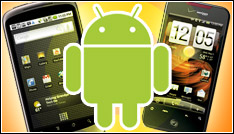Android smartphones are the biggest data hogs, consuming more data than iPhone users, according to network management specialist Arieso.
Using the iPhone 3G as a benchmark, the company found that Android handset owners notched higher data call volumes, time connected to the network, and data volume uploaded and downloaded than users of iPhones, Research In Motion BlackBerry or any other platform.
In Arieso’s example, Samsung Galaxy users uploaded 126 percent more data than iPhone 3G users, while HTC Desire users downloaded 41 percent more data than iPhone 3G users.
The Rise Of Android
Android has risen to capture 23.5 percent of US smartphone market share, coming within one market share point of the iPhone, according to comScore’s latest data.
 Arieso also found that iPhone 4 users “are more hungry for data than their iPhone 3G counterparts.” iPhone 4 users make 44 percent more data calls, download 41 percent more data to their devices and spend 67 percent more time connected to the network for data than do iPhone 3G users.
Arieso also found that iPhone 4 users “are more hungry for data than their iPhone 3G counterparts.” iPhone 4 users make 44 percent more data calls, download 41 percent more data to their devices and spend 67 percent more time connected to the network for data than do iPhone 3G users.
However, calling isn’t the big draw from today’s smartphone users, according to Arieso CTO Michael Flanagan.
Apps, Not Voice
Amid all of this data gluttony, voice calls per subscriber remain flat, leading to the conclusion that most Android and iPhone smartphone subscribers use their devices primarily for data consumption rather than making phone calls.
This is likely due to the tremendous boom in mobile application development on the Apple iOS and Android platforms in the last two years.
Apple’s App Store and Google’s Android Market offer more than 400,000 applications combined, with apps such as Rovio’s Angry Birds grabbing headlines.
TechCrunch said 8 December that Angry Birds sold more than 12 million copies and saw 30 million downloads. These are huge numbers for such a basic, frivolous app, where users assault pigs who stole their eggs.
What all of this points to, Flanagan said, is the need for network operators such as Verizon Wireless, which offers the popular Motorola Droid smartphone line, and exclusive iPhone carrier AT&T to prepare for the data crunch.
It’s a supreme Catch-22. These wireless carriers want consumers to keep using apps that inflate their data bills, but they also need to keep their pipes freed up for more data and, they hope, more subscribers.
“Smartphone subscriptions are rising and so too is subscriber appetite for mobile data,” Flanagan added. “Operators must now be able to quantify the impact of the devices they support, and how subscribers use them, and prepare their networks accordingly.”
Arieso has published the findings in its white paper “Emerging Smartphone Trends: The Next Wave in the Data Tsunami,” which is available upon request.




